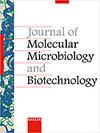Structure and Function of the Unusual Tungsten Enzymes Acetylene Hydratase and Class II Benzoyl-Coenzyme A Reductase
IF 1.2
Q2 Biochemistry, Genetics and Molecular Biology
引用次数: 26
Abstract
In biology, tungsten (W) is exclusively found in microbial enzymes bound to a bis-pyranopterin cofactor (bis-WPT). Previously known W enzymes catalyze redox oxo/hydroxyl transfer reactions by directly coordinating their substrates or products to the metal. They comprise the W-containing formate/formylmethanofuran dehydrogenases belonging to the dimethyl sulfoxide reductase (DMSOR) family and the aldehyde:ferredoxin oxidoreductase (AOR) families, which form a separate enzyme family within the Mo/W enzymes. In the last decade, initial insights into the structure and function of two unprecedented W enzymes were obtained: the acetaldehyde forming acetylene hydratase (ACH) belongs to the DMSOR and the class II benzoyl-coenzyme A (CoA) reductase (BCR) to the AOR family. The latter catalyzes the reductive dearomatization of benzoyl-CoA to a cyclic diene. Both are key enzymes in the degradation of acetylene (ACH) or aromatic compounds (BCR) in strictly anaerobic bacteria. They are unusual in either catalyzing a nonredox reaction (ACH) or a redox reaction without coordinating the substrate or product to the metal (BCR). In organic chemical synthesis, analogous reactions require totally nonphysiological conditions depending on Hg2+ (acetylene hydration) or alkali metals (benzene ring reduction). The structural insights obtained pave the way for biological or biomimetic approaches to basic reactions in organic chemistry.罕见的钨酶乙炔水合酶和II类苯甲酰辅酶A还原酶的结构和功能
在生物学中,钨(W)只存在于与双pyranopterin辅因子(bis-WPT)结合的微生物酶中。先前已知的W酶通过直接配位底物或产物与金属催化氧化还原氧/羟基转移反应。它们包括属于二甲基亚砜还原酶(DMSOR)家族的W-甲酸/甲酰基甲烷呋喃脱氢酶和醛:铁氧还蛋白氧化还原酶(AOR)家族,它们在Mo/W酶中形成一个单独的酶家族。在过去的十年里,人们对两种前所未有的W酶的结构和功能有了初步的了解:乙醛形成乙炔水合酶(ACH)属于DMSOR, II类苯甲酰辅酶A (CoA)还原酶(BCR)属于AOR家族。后者催化苯甲酰辅酶a还原脱芳为环二烯。两者都是严格厌氧细菌降解乙炔(ACH)或芳香族化合物(BCR)的关键酶。它们在催化非氧化还原反应(ACH)或不使底物或产物与金属配合的氧化还原反应(BCR)中都是不寻常的。在有机化学合成中,类似的反应需要完全非生理条件,依赖于Hg2+(乙炔水化)或碱金属(苯环还原)。所获得的结构见解为有机化学中基本反应的生物或仿生方法铺平了道路。
本文章由计算机程序翻译,如有差异,请以英文原文为准。
求助全文
约1分钟内获得全文
求助全文
来源期刊

Journal of Molecular Microbiology and Biotechnology
生物-生物工程与应用微生物
CiteScore
3.90
自引率
0.00%
发文量
0
审稿时长
>12 weeks
期刊介绍:
We are entering a new and exciting era of microbiological study and application. Recent advances in the now established disciplines of genomics, proteomics and bioinformatics, together with extensive cooperation between academic and industrial concerns have brought about an integration of basic and applied microbiology as never before.
 求助内容:
求助内容: 应助结果提醒方式:
应助结果提醒方式:


